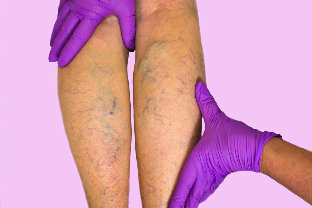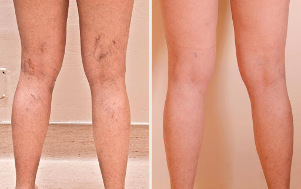This chronic disease of the veins, and by a thinning of the walls, the enlargement of the lumen, as well as the formation of nodes. Of the women and 20% men occurs in 40%.
This is a dangerous disease, mainly because of their complications. In the case of wrong or late treatment such terrible conditions develop, such as thrombosis and Thrombophlebitis, and bleeding from enlarged veins. Thrombosis (complete or partial closure of the lumen of the vein Thrombus) or Thrombophlebitis (an inflammatory disease of the vein wall, thrombosis) occurs suddenly, is not associated with physical activity. Swelling is rapidly spreading to the lower extremities, and accompanied with gripping pain. There may be redness or bruising, local pain of the skin. In the case of detachment of the Thrombus in the bloodstream it enters the blood vessels of the lungs, and in the case of a full or partial closure of the vessel is able to cause severe disease - pulmonary embolism. This complication is often fatal. Suspicion of these complications immediately to a horizontal Position, lift the feet upwards, on the phone to contact medical help. In the case of injuries in the area of the enlarged veins excessive bleeding can occur. In this case, urgently needs to walk impose on the location of the bleeding, Tourniquet (medical or improvised), strong enough, the bleeding has stopped, and immediately the ambulance medical care.
Thrombosis (complete or partial closure of the lumen of the vein Thrombus) or Thrombophlebitis (an inflammatory disease of the vein wall, thrombosis) occurs suddenly, is not associated with physical activity. Swelling is rapidly spreading to the lower extremities, and accompanied with gripping pain. There may be redness or bruising, local pain of the skin. In the case of detachment of the Thrombus in the bloodstream it enters the blood vessels of the lungs, and in the case of a full or partial closure of the vessel is able to cause severe disease - pulmonary embolism. This complication is often fatal. Suspicion of these complications immediately to a horizontal Position, lift the feet upwards, on the phone to contact medical help. In the case of injuries in the area of the enlarged veins excessive bleeding can occur. In this case, urgently needs to walk impose on the location of the bleeding, Tourniquet (medical or improvised), strong enough, the bleeding has stopped, and immediately the ambulance medical care.
The weakness of the muscular layer of the walls of the venous insufficiency and of the apparatus are the reason to flow under the influence of the effect of the "muscle pump" the blood starts to and in the opposite direction, down. This leads to increased pressure on the blood vessels, the progression, the further the insufficiency of the valves, the extension of the lumen of the veins and formation of nodes. The muscle fibers of the walls of the venous atrophy, impaired nerve receptors, the regulation of the venous tone, which in turn reinforces even more the symptoms of venous insufficiency. Risk factors for the disease are: hereditary predisposition, pregnancy, obesity, daily longer stay in a sitting Position or standing activities with lifting, systematic wearing tight clothes, corsets, improper diet, lack of roughage in the diet, and vitamin deficiency, disturbances of the hormonal Status.
Clinical Manifestations
The most important visible signs of varicose veins - or bag-shaped cylindrical Dilatation of the superficial veins. Varicose veins on the legs are branched, extend beyond the surface of the skin in the area of the legs and feet. A maximum of varices pronounced after severe or prolonged physical stress. In the early stage of the disease is concerned about increased fatigue, feeling of heaviness in the burn in the legs, bursting, the effects of which are maximum after physical stress. Can temporary edema, aching pain along the veins. Timely treatment to a specialist in the early stage to prevent the further development of the disease. With the progression of the disease chronic venous insufficiency formed.
The diagnosis of varicose veins
Gold standard of diagnosis is the ultrasonography of the veins of the lower extremity, in which the affected veins apply. On this principle is based on the anatomical classification of the varices, with an indication of the changes in the vessel wall. For example, the defeat of the great saphenous vein above or below the knee, Vena saphena Parva. In case of doubt, data from non-invasive methods are liable to resort to the surgical methods of research, for example, venography (an intravenous contrast medium, with the aim of assessing the venous system).
Treatment of varicose veins
Non-surgical treatment of varicose veins of the lower extremities provides good results only in the debut of the disease, if the skin symptoms are not pronounced and only moderately reduced work ability.
This surgical disease, complete healing of the to the surgical treatment:
- Phlebotomy - surgical removal of varicose veins enlarged veins. The aim of the Operation is the elimination of the pathological Reset the blood by the removal of the main strains is large or Vena saphena Parva, as well as the ligation of veins communicate. There are several types of operations. You apply almost always, even in difficult cases. In all these methods, a part of Vienna that impressed and healthy segments of Vienna maintained. Vienna as it was gently exfoliates and not from the cut tissue, the surgical Trauma is reduced. The same happens when using the surgical technique, and, in addition, less hematoma is formed, to reduce because of the cold spasm bleeding.
- Hardening - introduction to advanced vein a special substance (sclerosant), which is the "concentration" of the walls of the vein with the termination of blood flow to your. In the result of pathologic discharge of blood, lack of beauty, eliminates errors, since Vienna collapsed and was invisible. Sclerotherapy is effective only if the extension of the small branches of the large strains, which limits its application in the case of the major manifestations of the process. The advantage of sclerotherapy is the lack of scars, the need for hospitalization. After the sclerosis of the veins-specific Rehabilitation is not required.
- Laser coagulation method, based on the destruction of the walls of the veins, by the warm influence of the laser, leading to a "sharp" venous lumen. It is not only connected with the expansion of Vienna more than 10 mm-method with the implementation of the anesthesia. Cosmetically preferred, but such as after the removal of the vein requires an early activation of the patient, as well as a long elastic compression.














































